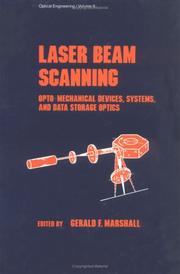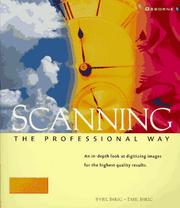| Listing 1 - 10 of 93 | << page >> |
Sort by
|
Book
ISBN: 9028608605 Year: 1981 Publisher: Alphen aan den Rijn : Sijthoff & Noordhoff,
Abstract | Keywords | Export | Availability | Bookmark
 Loading...
Loading...Choose an application
- Reference Manager
- EndNote
- RefWorks (Direct export to RefWorks)
Book
Year: 1980 Publisher: Marshall Space Flight Center, Alabama : George C. Marshall Space Flight Center,
Abstract | Keywords | Export | Availability | Bookmark
 Loading...
Loading...Choose an application
- Reference Manager
- EndNote
- RefWorks (Direct export to RefWorks)

ISBN: 0824774183 Year: 1985 Publisher: New York (N.Y.) : Dekker,
Abstract | Keywords | Export | Availability | Bookmark
 Loading...
Loading...Choose an application
- Reference Manager
- EndNote
- RefWorks (Direct export to RefWorks)

Abstract | Keywords | Export | Availability | Bookmark
 Loading...
Loading...Choose an application
- Reference Manager
- EndNote
- RefWorks (Direct export to RefWorks)
882145-2
Scanners (beeldverwerking) --- Scannen --- Scanner (beeldverwerking)
Book
ISBN: 2225831947 9782225831942 Year: 1997 Publisher: Paris: Masson,
Abstract | Keywords | Export | Availability | Bookmark
 Loading...
Loading...Choose an application
- Reference Manager
- EndNote
- RefWorks (Direct export to RefWorks)
Book
ISBN: 0892523336 Year: 1981 Publisher: Bellingham International society for optical engineering
Abstract | Keywords | Export | Availability | Bookmark
 Loading...
Loading...Choose an application
- Reference Manager
- EndNote
- RefWorks (Direct export to RefWorks)
Lasers --- Optical scanners --- Congresses --- Congresses
Book
Year: 2011 Publisher: [Place of publication not identified] : Taylor & Francis,
Abstract | Keywords | Export | Availability | Bookmark
 Loading...
Loading...Choose an application
- Reference Manager
- EndNote
- RefWorks (Direct export to RefWorks)
"Revealing the fundamentals of light beam deflection control, factors in image fidelity and quality, and the newest technological developments currently impacting scanner system design and applications, this highly practical reference reviews elements of laser beam characterization and describes optical systems for laser scanners. Featuring a logical chapter organization, authoritative yet accessible writing, hundreds of supporting illustrations, and contributions from 27 international subject specialists, this book affords a valuable range of perspectives as well as global coverage of optical and laser beam scanning. "-- Provided by publisher. "Preface Optical and laser scanning is the controlled deflection of light, visible or invisible. The aim of Handbook of Optical and Laser Scanning is to provide engineers, scientists, managerial technologists, and students with a resource to be used as a reference for understanding the fundamentals of optical scanning technology. This text has evolved from three previous books, Laser Beam Scanning (1985), Optical Scanning (1991), and Handbook of Optical and Laser Scanning (2004). Since their publication, many advances have occurred in optical scanning, requiring updating of previous material and introduction of additional scanning technologies. This new edition also adds a few chapters on scanning applications illustrating the practical use of scanning technology. Optical and laser scanning is a topic that is extremely broad in scope. It encompasses the mechanisms that control the deflection of light, optical systems that work with these mechanisms to perform scanning functions and factors that affect the fidelity of the images generated or obtained from the scanning systems. Each of these subtopics is addressed in this book from a variety of perspectives. A scanning system can be an input or output system or a combination of both. Input systems acquire images in either two or three dimensions. These systems can operate at a fixed wavelength or over a broad spectrum. They can reacquire the original light source by gathering either the specular or diffuse reflection or by fluorescing the image and acquiring the fluoresced light. Output systems direct light to produce images for applications such as marking, visual projection, and hard copy output. Ladar and many inspection systems use the same optical path to both illuminate the scene and acquire the image"-- Provided by publisher.
Book
Year: 2011 Publisher: [Place of publication not identified] : Taylor & Francis,
Abstract | Keywords | Export | Availability | Bookmark
 Loading...
Loading...Choose an application
- Reference Manager
- EndNote
- RefWorks (Direct export to RefWorks)
"Revealing the fundamentals of light beam deflection control, factors in image fidelity and quality, and the newest technological developments currently impacting scanner system design and applications, this highly practical reference reviews elements of laser beam characterization and describes optical systems for laser scanners. Featuring a logical chapter organization, authoritative yet accessible writing, hundreds of supporting illustrations, and contributions from 27 international subject specialists, this book affords a valuable range of perspectives as well as global coverage of optical and laser beam scanning. "-- Provided by publisher. "Preface Optical and laser scanning is the controlled deflection of light, visible or invisible. The aim of Handbook of Optical and Laser Scanning is to provide engineers, scientists, managerial technologists, and students with a resource to be used as a reference for understanding the fundamentals of optical scanning technology. This text has evolved from three previous books, Laser Beam Scanning (1985), Optical Scanning (1991), and Handbook of Optical and Laser Scanning (2004). Since their publication, many advances have occurred in optical scanning, requiring updating of previous material and introduction of additional scanning technologies. This new edition also adds a few chapters on scanning applications illustrating the practical use of scanning technology. Optical and laser scanning is a topic that is extremely broad in scope. It encompasses the mechanisms that control the deflection of light, optical systems that work with these mechanisms to perform scanning functions and factors that affect the fidelity of the images generated or obtained from the scanning systems. Each of these subtopics is addressed in this book from a variety of perspectives. A scanning system can be an input or output system or a combination of both. Input systems acquire images in either two or three dimensions. These systems can operate at a fixed wavelength or over a broad spectrum. They can reacquire the original light source by gathering either the specular or diffuse reflection or by fluorescing the image and acquiring the fluoresced light. Output systems direct light to produce images for applications such as marking, visual projection, and hard copy output. Ladar and many inspection systems use the same optical path to both illuminate the scene and acquire the image"-- Provided by publisher.
Book
Year: 2011 Publisher: [Place of publication not identified] : Taylor & Francis,
Abstract | Keywords | Export | Availability | Bookmark
 Loading...
Loading...Choose an application
- Reference Manager
- EndNote
- RefWorks (Direct export to RefWorks)
"Revealing the fundamentals of light beam deflection control, factors in image fidelity and quality, and the newest technological developments currently impacting scanner system design and applications, this highly practical reference reviews elements of laser beam characterization and describes optical systems for laser scanners. Featuring a logical chapter organization, authoritative yet accessible writing, hundreds of supporting illustrations, and contributions from 27 international subject specialists, this book affords a valuable range of perspectives as well as global coverage of optical and laser beam scanning. "-- Provided by publisher. "Preface Optical and laser scanning is the controlled deflection of light, visible or invisible. The aim of Handbook of Optical and Laser Scanning is to provide engineers, scientists, managerial technologists, and students with a resource to be used as a reference for understanding the fundamentals of optical scanning technology. This text has evolved from three previous books, Laser Beam Scanning (1985), Optical Scanning (1991), and Handbook of Optical and Laser Scanning (2004). Since their publication, many advances have occurred in optical scanning, requiring updating of previous material and introduction of additional scanning technologies. This new edition also adds a few chapters on scanning applications illustrating the practical use of scanning technology. Optical and laser scanning is a topic that is extremely broad in scope. It encompasses the mechanisms that control the deflection of light, optical systems that work with these mechanisms to perform scanning functions and factors that affect the fidelity of the images generated or obtained from the scanning systems. Each of these subtopics is addressed in this book from a variety of perspectives. A scanning system can be an input or output system or a combination of both. Input systems acquire images in either two or three dimensions. These systems can operate at a fixed wavelength or over a broad spectrum. They can reacquire the original light source by gathering either the specular or diffuse reflection or by fluorescing the image and acquiring the fluoresced light. Output systems direct light to produce images for applications such as marking, visual projection, and hard copy output. Ladar and many inspection systems use the same optical path to both illuminate the scene and acquire the image"-- Provided by publisher.
Book
Year: 1996 Publisher: Cleveland, Ohio : National Aeronautics and Space Administration, Lewis Research Center,
Abstract | Keywords | Export | Availability | Bookmark
 Loading...
Loading...Choose an application
- Reference Manager
- EndNote
- RefWorks (Direct export to RefWorks)
Ultrasonics. --- Imaging techniques. --- Scanners. --- Technology transfer. --- Reflectors.
| Listing 1 - 10 of 93 | << page >> |
Sort by
|

 Search
Search Feedback
Feedback About
About Help
Help News
News